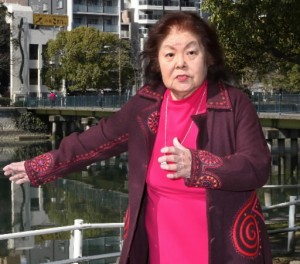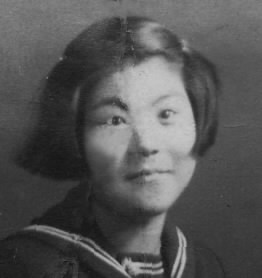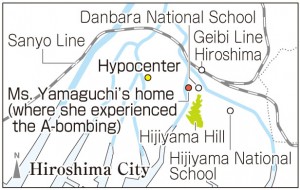Survivors’ Stories: Keiko Yamaguchi, 86, Minami Ward, Hiroshima
Feb. 20, 2017
Despite hardships, moving forward with her life
by Rie Nii, Staff Writer
Keiko Yamaguchi (née Ueno), 86, suffered a bad wound on the back of her head at the time of the atomic bombing. Even after the war she experienced pain, and she felt depressed for a long time. Still, she said she was fortunate because her mother had managed to survive. Ms. Yamaguchi has always tried to move forward with her life and live cheerfully.
Back then, she was 15 years old, a fourth-year student at Hiroshima First Municipal Girls’ School (today’s Funairi High School). When she was in her third year, she took a sewing machine from home to school and sewed military uniforms and mosquito nets to be used by soldiers on the front lines. And in her fourth year, she used a lathe to make bullets at the Hiroshima factory of the Japan Steel Works (now part of Minami Ward).
On August 6, 1945, the factory was closed due to a lack of electricity. At her home in Dote-cho (now Inari-machi in Naka Ward, about 1.5 kilometers from the hypocenter), Ms. Yamaguchi was planning to go to the seaside with some croquettes made by her mother, Mikie. The moment she sat on the kitchen floor, there was a flash from above and a great boom, then everything went black. Things were falling in the house and she fled frantically.
As her surroundings gradually grew lighter, she saw that their house had been destroyed. At the same time, she realized that blood was dripping down from behind her right ear. When she touched the wound, it was big enough to fit her middle finger. She thought that she would die at any time, and she wanted to see her mother before she died. When she took a few steps toward Danbara National School (now Danbara Elementary School), where her mother worked as a nurse, she spotted her mother coming her way and smiling. Looking back at that moment, Ms. Yamaguchi said, “I’ve never forgotten that smile.”
Her mother bandaged her head, and the two fled together. From Tamonin Temple, they went up Hijiyama Hill, passed in front of Hijiyama National School (now Hijiyama Elementary School), and arrived at a relative’s house located in the Niho district (now part of Minami Ward). One of her mother’s colleagues lived near there and put them up that night.
The following morning, they fled to the Yamanouchi district (now part of the city of Shobara) in northern Hiroshima Prefecture on the Geibi Line, where the students of Danbara National School had been relocated, and they stayed there until the end of August. Only mercurochrome was applied to the wound on her head. She lost her hair and for many years was in poor health. Self-conscious of the scar that remained, she began wearing her hair long.
After returning to Hiroshima, they rented a relative’s shed and Ms. Yamaguchi attended school. She graduated in March 1946. That November, her sister Kyoko was born. With her mother working, Keiko did the housework and looked after her sister. Her sister was cute, but the cold seeped through the walls of the shed and she had to draw water from a well. She also recalls feeling embarrassed going down to the sea to wash her sister’s diapers. It was a tough time in her life. In bed at night, she would tell herself: “Everyone experiences many things, but not all of them are bad. There will be good times, too, someday.”
Through an acquaintance, she met and married her husband, Yoshihiro, in 1953. He also experienced the atomic bombing, but this didn’t concern her. “We needn’t hide our A-bomb experiences,” she said firmly. “If you check our backgrounds, you’ll find this fact, anyway. People who are prejudiced against us because of this are foolish.” Her husband worked for the Hiroshima municipal government for many years and was involved in building bridges. She is proud of the efforts he made to help reconstruct the city of Hiroshima.
About 60 years have passed since she first joined a singing group, the PTA chorus when her eldest son was in first grade. She now belongs to a chorus group in Hiroshima and has never missed a single practice, held every Monday evening. She says she looks forward to the annual concert that they hold. Helping to organize a class reunion for alumni of Hiroshima First Municipal Girls’ School, twice a year, also gives her something to live for.
She hopes junior high and senior high school students will study hard and learn about the world. She added that it is important to speak kindly to others.
Teenagers’ Impressions
Keeping her words in mind
“What an absurd time it was in Japan, with children making weapons,” Ms. Yamaguchi said. “I hope you’ll learn a lot and help create a peaceful world.” Keeping her words in mind, I want to study and think about how we can promote greater peace, even if just a little, so that war won’t take place again and involve a lot of children. (Kotoori Kawagishi, 14)
Taking quick action is important
When many things were crashing down around her, Ms. Yamaguchi fled the house frantically. If I had been in her shoes, I wouldn’t have been able to take such quick action. I would have been so shocked and frozen in place. I learned from her that it’s important to quickly take decisive action, whenever something unexpected happens. (Felix Walsh, 14)
Scared of life suddenly changing
Ms. Yamaguchi said that her life changed completely after the atomic bombing, which left a strong impression on me. If I imagine myself getting injured, losing my home in an instant, and my whole environment suddenly changed, I feel so scared. She cooked and took care of her little sister while her mother was working. These are things that I don’t think I could do. I want to appreciate the life I have now. (Aoi Nakagawa, 16)
(Originally published on February 20, 2017)
by Rie Nii, Staff Writer
Keiko Yamaguchi (née Ueno), 86, suffered a bad wound on the back of her head at the time of the atomic bombing. Even after the war she experienced pain, and she felt depressed for a long time. Still, she said she was fortunate because her mother had managed to survive. Ms. Yamaguchi has always tried to move forward with her life and live cheerfully.
Back then, she was 15 years old, a fourth-year student at Hiroshima First Municipal Girls’ School (today’s Funairi High School). When she was in her third year, she took a sewing machine from home to school and sewed military uniforms and mosquito nets to be used by soldiers on the front lines. And in her fourth year, she used a lathe to make bullets at the Hiroshima factory of the Japan Steel Works (now part of Minami Ward).
On August 6, 1945, the factory was closed due to a lack of electricity. At her home in Dote-cho (now Inari-machi in Naka Ward, about 1.5 kilometers from the hypocenter), Ms. Yamaguchi was planning to go to the seaside with some croquettes made by her mother, Mikie. The moment she sat on the kitchen floor, there was a flash from above and a great boom, then everything went black. Things were falling in the house and she fled frantically.
As her surroundings gradually grew lighter, she saw that their house had been destroyed. At the same time, she realized that blood was dripping down from behind her right ear. When she touched the wound, it was big enough to fit her middle finger. She thought that she would die at any time, and she wanted to see her mother before she died. When she took a few steps toward Danbara National School (now Danbara Elementary School), where her mother worked as a nurse, she spotted her mother coming her way and smiling. Looking back at that moment, Ms. Yamaguchi said, “I’ve never forgotten that smile.”
Her mother bandaged her head, and the two fled together. From Tamonin Temple, they went up Hijiyama Hill, passed in front of Hijiyama National School (now Hijiyama Elementary School), and arrived at a relative’s house located in the Niho district (now part of Minami Ward). One of her mother’s colleagues lived near there and put them up that night.
The following morning, they fled to the Yamanouchi district (now part of the city of Shobara) in northern Hiroshima Prefecture on the Geibi Line, where the students of Danbara National School had been relocated, and they stayed there until the end of August. Only mercurochrome was applied to the wound on her head. She lost her hair and for many years was in poor health. Self-conscious of the scar that remained, she began wearing her hair long.
After returning to Hiroshima, they rented a relative’s shed and Ms. Yamaguchi attended school. She graduated in March 1946. That November, her sister Kyoko was born. With her mother working, Keiko did the housework and looked after her sister. Her sister was cute, but the cold seeped through the walls of the shed and she had to draw water from a well. She also recalls feeling embarrassed going down to the sea to wash her sister’s diapers. It was a tough time in her life. In bed at night, she would tell herself: “Everyone experiences many things, but not all of them are bad. There will be good times, too, someday.”
Through an acquaintance, she met and married her husband, Yoshihiro, in 1953. He also experienced the atomic bombing, but this didn’t concern her. “We needn’t hide our A-bomb experiences,” she said firmly. “If you check our backgrounds, you’ll find this fact, anyway. People who are prejudiced against us because of this are foolish.” Her husband worked for the Hiroshima municipal government for many years and was involved in building bridges. She is proud of the efforts he made to help reconstruct the city of Hiroshima.
About 60 years have passed since she first joined a singing group, the PTA chorus when her eldest son was in first grade. She now belongs to a chorus group in Hiroshima and has never missed a single practice, held every Monday evening. She says she looks forward to the annual concert that they hold. Helping to organize a class reunion for alumni of Hiroshima First Municipal Girls’ School, twice a year, also gives her something to live for.
She hopes junior high and senior high school students will study hard and learn about the world. She added that it is important to speak kindly to others.
Teenagers’ Impressions
Keeping her words in mind
“What an absurd time it was in Japan, with children making weapons,” Ms. Yamaguchi said. “I hope you’ll learn a lot and help create a peaceful world.” Keeping her words in mind, I want to study and think about how we can promote greater peace, even if just a little, so that war won’t take place again and involve a lot of children. (Kotoori Kawagishi, 14)
Taking quick action is important
When many things were crashing down around her, Ms. Yamaguchi fled the house frantically. If I had been in her shoes, I wouldn’t have been able to take such quick action. I would have been so shocked and frozen in place. I learned from her that it’s important to quickly take decisive action, whenever something unexpected happens. (Felix Walsh, 14)
Scared of life suddenly changing
Ms. Yamaguchi said that her life changed completely after the atomic bombing, which left a strong impression on me. If I imagine myself getting injured, losing my home in an instant, and my whole environment suddenly changed, I feel so scared. She cooked and took care of her little sister while her mother was working. These are things that I don’t think I could do. I want to appreciate the life I have now. (Aoi Nakagawa, 16)
(Originally published on February 20, 2017)










